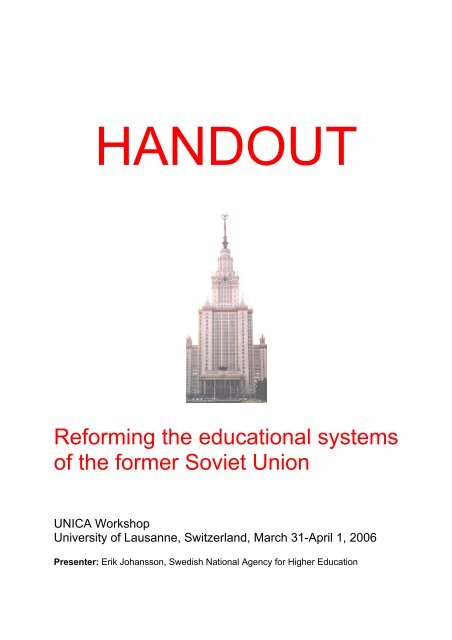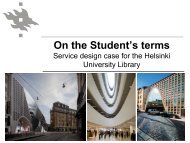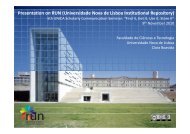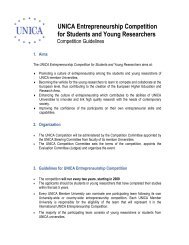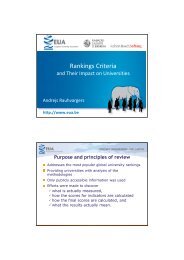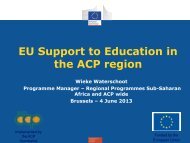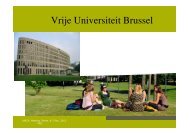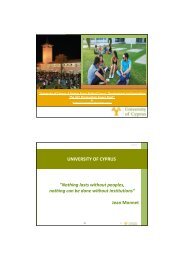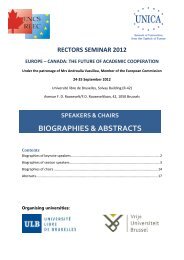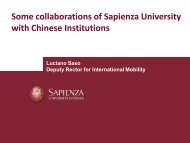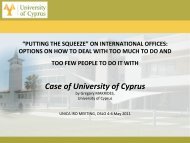Reforming the educational systems of the former Soviet Union - UNICA
Reforming the educational systems of the former Soviet Union - UNICA
Reforming the educational systems of the former Soviet Union - UNICA
Create successful ePaper yourself
Turn your PDF publications into a flip-book with our unique Google optimized e-Paper software.
HANDOUT<br />
<strong>Reforming</strong> <strong>the</strong> <strong>educational</strong> <strong>systems</strong><br />
<strong>of</strong> <strong>the</strong> <strong>former</strong> <strong>Soviet</strong> <strong>Union</strong><br />
<strong>UNICA</strong> Workshop<br />
University <strong>of</strong> Lausanne, Switzerland, March 31-April 1, 2006<br />
Presenter: Erik Johansson, Swedish National Agency for Higher Education
INDEX<br />
Introduction 3<br />
Indicators <strong>of</strong> reform 3<br />
A. Reformed <strong>educational</strong> <strong>systems</strong> 4<br />
Example: The <strong>educational</strong> system <strong>of</strong> Uzbekistan 4<br />
B. Partly reformed <strong>educational</strong> <strong>systems</strong> 5<br />
Example: The <strong>educational</strong> system <strong>of</strong> Kazakhstan 6<br />
C. Stagnated <strong>educational</strong> <strong>systems</strong> 8<br />
Example: The <strong>educational</strong> system <strong>of</strong> Belarus 9<br />
Appendix 1. The <strong>educational</strong> system <strong>of</strong> Uzbekistan 11<br />
Appendix 2. The <strong>educational</strong> system <strong>of</strong> Kazakhstan 12<br />
Appendix 3. The <strong>educational</strong> system <strong>of</strong> Belarus 13<br />
Appendix 4. Sample degrees 14<br />
Appendix 5: Translation <strong>of</strong> Uzbek transcript (2001) 17<br />
Resources 19<br />
2
INTRODUCTION<br />
This handout is meant to serve as a general overview <strong>of</strong> <strong>the</strong> changes in <strong>the</strong> higher<br />
education sector in <strong>the</strong> following twelve states <strong>of</strong> <strong>the</strong> <strong>former</strong> <strong>Soviet</strong> <strong>Union</strong>: Armenia,<br />
Azerbaijan, Belarus, Georgia, Kazakhstan, Kyrgyzstan, Moldova, Russia, Tajikistan,<br />
Turkmenistan, Ukraine, and Uzbekistan. The handout will focus on <strong>the</strong> reforms <strong>of</strong><br />
<strong>educational</strong> <strong>systems</strong> <strong>of</strong> <strong>the</strong> region in general and Uzbekistan, Kazakhstan, and<br />
Belarus in particular.<br />
INDICATORS OF REFORM<br />
In order to study <strong>the</strong> <strong>educational</strong> reforms that have taken place in <strong>the</strong> region since<br />
independence in 1991, <strong>the</strong> following eight indicators <strong>of</strong> reform have been identified:<br />
1. Extension <strong>of</strong> secondary education to 11-12 years<br />
2. Commitment to <strong>the</strong> Bologna Process<br />
3. Introduction <strong>of</strong> a 2-level Bachelor/Master degree structure<br />
4. National entrance exams<br />
5. Private institutions<br />
6. Foreign institutions<br />
7. Quality assurance system based on 3-stage licensing, attestation, and<br />
accreditation<br />
8. Credit system<br />
Based on <strong>the</strong>se criteria, <strong>the</strong> studied <strong>educational</strong> <strong>systems</strong> fit into <strong>the</strong> following three<br />
categories: A. reformed, B. partly reformed, and C. stagnated.<br />
Figure 1. Educational reform in <strong>the</strong> <strong>former</strong> <strong>Soviet</strong> <strong>Union</strong> – A comparison<br />
11-12 y. Bologna Bachelor/ Nat'l Private Foreign QA/ Credit<br />
School Process Master Exams HEIs HEIs Accred. System<br />
E. Europe<br />
Russia X (X) (X) X (X) X<br />
Ukraine X X (X) (X) X X X<br />
Belarus (X) X (X) X X<br />
Moldova X X (X) X X<br />
S. Caucasus<br />
Armenia (X) X (X) X X X X<br />
Azerbaijan X X X X (X) (X)<br />
Georgia X (X) X X (X) X<br />
Central Asia<br />
Kazakhstan (X) (X) (X) X X X (X)<br />
Kyrgyzstan (X) (X) X X X (X)<br />
Tajikistan (X) X X<br />
Turkmenistan<br />
(X)<br />
Uzbekistan X (X) X X (X) X X<br />
Legend: X Reform introduced and fully implemented<br />
(X) Reform introduced, but not fully implemented<br />
3
A. REFORMED EDUCATIONAL SYSTEMS<br />
Countries: Armenia, Ukraine, and Uzbekistan<br />
Significant for this group is that it has introduced many <strong>educational</strong> reforms in<br />
combination with a relatively high rate <strong>of</strong> implementation. To this geographically<br />
dispersed group we count Armenia, Ukraine, and Uzbekistan. These three nations<br />
have introduced reforms that have extended <strong>the</strong> duration <strong>of</strong> <strong>the</strong>ir primary and<br />
secondary education to 11-12 years, are committed to <strong>the</strong> Bologna Process, have<br />
fully or partially reformed <strong>the</strong>ir degree structures by introducing <strong>the</strong> Bachelor’s and<br />
Master’s degrees, introduced national entrance exams, and allow private and foreign<br />
institutions to operate. Additionally, Armenia and Ukraine have introduced and fully<br />
implemented a quality assurance system based on accreditation, whereas<br />
Uzbekistan has abolished <strong>the</strong> <strong>Soviet</strong> system <strong>of</strong> study load expressed in hours and<br />
replaced with a new credit system.<br />
Example: The <strong>educational</strong> system <strong>of</strong> Uzbekistan<br />
Extending primary and secondary education and <strong>the</strong> national entrance exam<br />
Uzbek children begin school at age 6 or 7 and following <strong>the</strong> 1998 reform primary and<br />
secondary education in Uzbekistan was extended from 10-11 years to 11-12 years,<br />
according to <strong>the</strong> formula 4+5+3. In 2001 <strong>the</strong> first students having completed 11-12<br />
years <strong>of</strong> primary and secondary education were admitted to universities.<br />
Postsecondary vocational schools have been renamed and are now called colleges.<br />
Higher education usually begins at age 18-19 and high school graduates first<br />
choose which institution to attend and <strong>the</strong>n write <strong>the</strong> National Entrance Exam [kirish<br />
imtikhoni] based on multiple-choice questions. (Uzbekistan was <strong>the</strong> first CIS member<br />
state to introduce a single, nationwide standardized set <strong>of</strong> exams.) Students take <strong>the</strong><br />
aptitude test on August 1 each year and testing is organized by <strong>the</strong> State Center for<br />
Testing [Davlat Test Markazi]. In 2002 approximately 300,000 students took <strong>the</strong> test<br />
out <strong>of</strong> which 60 % gained access to higher education. Also college graduates can<br />
apply to institutions <strong>of</strong> higher education, however, not to all academic programs.<br />
Breaking with <strong>the</strong> past – Uzbekistan’s new degree structure<br />
There are 63 institutions <strong>of</strong> higher education in Uzbekistan and most <strong>of</strong> <strong>the</strong>m are<br />
located in <strong>the</strong> cities Andizhan, Bukhara, Fergana, Nukus, Samarkand and <strong>the</strong> capital<br />
Tashkent. All institutions are run by <strong>the</strong> state and have <strong>the</strong> right to issue degrees in<br />
<strong>the</strong> state format.<br />
Uzbekistan experimented with private institutions in <strong>the</strong> 1990s, but <strong>the</strong> Ministry<br />
<strong>of</strong> Higher and Secondary Specialized Education <strong>of</strong> <strong>the</strong> Republic <strong>of</strong> Uzbekistan<br />
[O'zbekiston Respublikasi Oliy va O'rta Maxsus Ta'lim Vazirligi] was soon concerned<br />
about <strong>the</strong> quality <strong>of</strong> education at <strong>the</strong>se institutions. For example, applicants that did<br />
not pass <strong>the</strong> entrance exams to state (public) institutions were automatically admitted<br />
to private ones instead. Against this background and allegedly due to substandard<br />
conditions, <strong>the</strong> Ministry closed all private institutions during <strong>the</strong> period 1995-1998.<br />
Despite a new law <strong>of</strong> 2002 making it once again legal for non-state institutions<br />
to operate, <strong>the</strong>re are at present no private institutions in Uzbekistan. Two foreign<br />
institutions that are not under <strong>the</strong> auspices <strong>of</strong> <strong>the</strong> Uzbek Ministry <strong>of</strong> Education have,<br />
however, been established in Tashkent: The International Westminster University<br />
4
(UK) and <strong>the</strong> Tashkent branch <strong>of</strong> <strong>the</strong> Plekhanov Russian Academy <strong>of</strong> Economics<br />
(Russia).<br />
In contrast to o<strong>the</strong>r Central Asian republics, Uzbekistan has taken <strong>the</strong> reform <strong>of</strong><br />
its degree structure one step fur<strong>the</strong>r by abolishing <strong>the</strong> traditional <strong>Soviet</strong> Specialist<br />
degree and replacing it with a two tier system based on <strong>the</strong> Western-style Bachelor<br />
[Bakalavr diplomi] and Master degree [Magistr diplomi]. In o<strong>the</strong>r words, <strong>the</strong> Uzbek<br />
degree structure is less <strong>of</strong> a hybrid than that <strong>of</strong> Kazakhstan and Kyrgyzstan.<br />
Exceptions to <strong>the</strong> rule are, however, degrees in health pr<strong>of</strong>essions (dentistry and<br />
medicine) and degrees on <strong>the</strong> doctoral level, i.e. <strong>the</strong> Candidate <strong>of</strong> Science [fanlari<br />
nomzodi] and Doctor <strong>of</strong> Science [fanlari doktori] degrees.<br />
Uzbekistan has, fur<strong>the</strong>rmore, introduced a new grading and credit system. The<br />
new so-called reyting system is based on a percentage scale: 86-100 % = excellent<br />
[a’lo], 71-85 % good [yaxshi], 56-70 % satisfactory [qoniqarli] and
Example: The <strong>educational</strong> system <strong>of</strong> Kazakhstan<br />
Primary and secondary education<br />
After 1996 <strong>the</strong> nominal length was <strong>of</strong>ficially extended to 12 years, thus moving from a<br />
4+5+2 system to a 4+5+3 system. The reform has, however, not yet been<br />
implemented in all parts <strong>of</strong> <strong>the</strong> country.<br />
Students graduating from grade 9 have <strong>the</strong> option to ei<strong>the</strong>r to continue on to<br />
complete general secondary education or pursue vocational training at one <strong>of</strong> <strong>the</strong><br />
following types post-secondary vocational schools:<br />
• Vocational school [училище (Kazakh/Russian)]<br />
• Technical school [техникум(Kazakh/Russian)]<br />
• College [колледж (Kazakh/Russian)]<br />
These programs are <strong>of</strong> 2-4 years <strong>of</strong> length depending on <strong>the</strong> chosen field. Colleges<br />
are new type <strong>of</strong> institutions <strong>of</strong>fering specialist training. Some <strong>of</strong> <strong>the</strong>m are affiliated<br />
with higher education institutions. Graduates from <strong>the</strong>se schools who pursue higher<br />
education may be considered for advanced standing, thus completing e.g. 4-year<br />
academic program in only 3 years.<br />
Admission to higher education<br />
Admission to higher education is based both on <strong>the</strong> leaving certificate from high<br />
school [Орта білім туралы аттестат (Kazakh)/Аттестат о среднем (полном)<br />
общем образовании (Russian)] and (as <strong>of</strong> 2004) results from <strong>the</strong> so-called Unified<br />
National Testing Exam, UNT [Бүтін ұлттық тест тапсыру (ҰБТ) (Kazakh)/Единое<br />
национальное тестирование (ЕНТ) (Russian)]– a single, nationwide standardized<br />
set <strong>of</strong> exams. Thus, in addition to <strong>the</strong> common Certificate <strong>of</strong> (Complete) Secondary<br />
Education school leavers receive <strong>the</strong> Certificate <strong>of</strong> Results from <strong>the</strong> Unified National<br />
Testing Exam. All school leavers planning to continue on to higher education must<br />
pass <strong>the</strong> UNT and based on <strong>the</strong> two documents school graduates are able to apply<br />
to several different universities all over <strong>the</strong> Republic. The UNT includes 120<br />
questions and take three hours to complete. The UNT covers <strong>the</strong> three mandatory<br />
subjects Kazakh/Russian, ma<strong>the</strong>matics, History <strong>of</strong> Kazakhstan and one optional<br />
subject.<br />
An expanding private sector<br />
There are <strong>the</strong> following types <strong>of</strong> higher education institutions in <strong>the</strong> Republic <strong>of</strong><br />
Kazakhstan:<br />
• University [университет (Kazakh/Russian)]<br />
• Academy [академия (Kazakh/Russian)]<br />
• Institute [институт (Kazakh/Russian)]<br />
• Conservatory [консерватория (Kazakh/Russian)]<br />
• Higher school [жоғары мектеп (Kazakh)/высшая школа (Russian)]<br />
• Higher vocational schools [жоғары училище (Kazakh)/высшее училище<br />
(Russian)]<br />
6
Since <strong>the</strong> collapse <strong>of</strong> <strong>the</strong> <strong>Soviet</strong> <strong>Union</strong> both <strong>the</strong> number <strong>of</strong> students and institutions <strong>of</strong><br />
higher education in Kazakhstan has increased dramatically. In 2003 <strong>the</strong> country had<br />
657.000 students; 359.000 (55 %) in state and 298.000 (45 %) in non-state<br />
institutions, respectively. And in <strong>the</strong> period 1992-2004 <strong>the</strong> number <strong>of</strong> (predominately<br />
private) institutions grew from 45 to 168, including 56 state institutions and 112 nonstate<br />
(private) institutions. Among <strong>the</strong> state institutions <strong>the</strong>re are nine elite national<br />
universities that are autonomous and fully government-funded (e.g. <strong>the</strong> Kazakh<br />
National Technical University). The remaining state institutions are partly funded by<br />
<strong>the</strong> state. The private institutions are, however, self-funded.<br />
The Ministry <strong>of</strong> Education and Science is responsible for quality assurance,<br />
state standards in higher education and decides which institutions that have <strong>the</strong> right<br />
to grant degrees. The basis for quality assurance in Kazakh higher education is (as in<br />
most <strong>former</strong> <strong>Soviet</strong> republics) <strong>the</strong> 3-stage process called licensing, attestation and<br />
accreditation. For an education institution to legally operate in Kazakhstan it is<br />
necessary that it is licensed. All 168 institutions <strong>of</strong> higher education are licensed. The<br />
state license is granted to institutions <strong>of</strong> higher education by <strong>the</strong> Ministry and does<br />
not imply any quality control. All licensed institutions have <strong>the</strong> right to issue diplomas<br />
in <strong>the</strong> state format.<br />
The purpose <strong>of</strong> attestation is to check whe<strong>the</strong>r an institution meets <strong>the</strong> state<br />
<strong>educational</strong> standards and it is a prerequisite for accreditation. Thus, in contrast to<br />
licensing, <strong>the</strong> focus <strong>of</strong> attestation is quality assurance. The Ministry conducts<br />
attestation in five-year cycles. Institutions that have completed <strong>the</strong> above-mentioned<br />
licensing and attestation procedures with positive conclusions can receive <strong>the</strong> highest<br />
form <strong>of</strong> state recognition: accreditation.<br />
The accreditation process is conducted by <strong>the</strong> Ministry and is applicable to both<br />
state and non-state institutions alike. Accreditation not only applies to <strong>the</strong> institution<br />
as such but also to academic programs <strong>of</strong>fered at <strong>the</strong> institution. Accreditation can be<br />
suspended at any moment if shortcomings are discovered. All state institutions in<br />
Kazakhstan have state accreditation, whereas, only a few private institutions are<br />
accredited.<br />
As <strong>of</strong> early 2004 accreditation, however, exists on paper only. Due to alleged<br />
discontent in academia and <strong>the</strong> public <strong>the</strong> accreditation <strong>of</strong> higher education<br />
institutions has been suspended, pending reform and <strong>the</strong> establishment <strong>of</strong> a national<br />
accreditation center. Thus leaving licensing and attestation as <strong>the</strong> only de facto<br />
quality assurance mechanism in Kazakh higher education still in place. Details<br />
surrounding <strong>the</strong>se recent changes are still unclear.<br />
The many new institutions that popped up in <strong>the</strong> 1990s have <strong>of</strong> course brought<br />
freedom <strong>of</strong> choice to <strong>the</strong> students <strong>of</strong> this <strong>former</strong> <strong>Soviet</strong> republic. The enormous<br />
growth <strong>of</strong> <strong>the</strong> number <strong>of</strong> institutions is, however, a mixed blessing; it is becoming<br />
increasingly difficult for <strong>the</strong> Ministry <strong>of</strong> Education and Science to guarantee <strong>the</strong><br />
quality <strong>of</strong> higher education at all 168 institutions in <strong>the</strong> country with <strong>the</strong> new private<br />
institutions constituting <strong>the</strong> biggest headache. Against this background, several nonstate<br />
institutions and campuses have been closed in recent years (in <strong>the</strong> period<br />
2001-2003 alone 65 campuses were closed) and <strong>the</strong> number <strong>of</strong> private institutions<br />
will probably fur<strong>the</strong>r decrease in <strong>the</strong> years to come.<br />
7
Figure 2. The growth <strong>of</strong> <strong>the</strong> number <strong>of</strong> HEIs in Kazakhstan during <strong>the</strong> period 1992-2004<br />
140<br />
120<br />
100<br />
99<br />
111 112<br />
123<br />
113 114 112<br />
HEIs<br />
80<br />
60<br />
40<br />
45<br />
71<br />
54 51 52<br />
58 61 63 63<br />
56<br />
State<br />
Non-state<br />
20<br />
0<br />
0<br />
1991 1997 1998 1999 2000 2001 2002 2003 2004<br />
Year<br />
New degrees<br />
During <strong>the</strong> period 1995-1996 <strong>the</strong> Kazakh higher education system was reformed and<br />
<strong>the</strong> Western-style Degree <strong>of</strong> Bachelor [Бакалавр дипломы (Kazakh)/Диплом<br />
бакалавра (Russian] and Master [Магистр дипломы (Kazakh)/Диплом магистра<br />
(Russian] were introduced parallel with <strong>the</strong> traditional (<strong>Soviet</strong> era) 4-6 year Specialist<br />
degree [Мамаң дипломы (Kazakh)/Диплом специалиста (Russian]. The doctoral<br />
level has, however, not been affected by reform; <strong>the</strong> <strong>Soviet</strong> era Candidate <strong>of</strong> Science<br />
[Ғылым кандидаты (Kazakh)/Кандидат наук (Russian)] and Doctor <strong>of</strong> Science<br />
[Ғылым докторы (Kazakh)/Доктор наук (Russian)] degrees still exist.<br />
The Bachelor’s degree normally takes four years to complete, whereas <strong>the</strong><br />
Master’s degree program takes an additional two years. On <strong>the</strong> o<strong>the</strong>r hand,<br />
graduates from so-called colleges may complete a Bachelor’s degree program in only<br />
three years and graduates from four- or five-year specialist programs may complete<br />
<strong>the</strong>ir Master’s degree program in one year. Fur<strong>the</strong>rmore, graduates from classical<br />
universities can complete Candidate <strong>of</strong> Science programs in only 2 years, whereas<br />
<strong>the</strong> rest are required to study for 3 years or longer.<br />
In 2004 Kazakhstan applied for participation/membership in <strong>the</strong> Bologna<br />
Process, yet was denied membership since is not within <strong>the</strong> group <strong>of</strong> states that have<br />
ratified <strong>the</strong> European Cultural Convention (membership criterion). Never<strong>the</strong>less,<br />
Kazakhstan is reforming its higher education system along <strong>the</strong> general lines <strong>of</strong> <strong>the</strong><br />
Bologna Process.<br />
C. STAGNATED EDUCATIONAL SYSTEMS<br />
Countries: Belarus, Tajikistan, and Turkmenistan<br />
Typical <strong>of</strong> this category is an unwillingness to reform that has left many <strong>of</strong> <strong>the</strong><br />
features <strong>of</strong> <strong>the</strong> <strong>Soviet</strong> centralized education system intact. Belarus with its expressed<br />
disinterest in <strong>the</strong> Bologna Process and piecemeal elimination <strong>of</strong> <strong>the</strong> private<br />
8
<strong>educational</strong> sector in recent years has contributed to <strong>the</strong> fur<strong>the</strong>r stagnation <strong>of</strong> <strong>the</strong><br />
country’s <strong>educational</strong> system. Fur<strong>the</strong>rmore, Tajikistan has despite efforts to reform its<br />
degree structure and <strong>the</strong> establishment <strong>of</strong> foreign institutions undergone few changes<br />
since <strong>the</strong> disintegration <strong>of</strong> <strong>the</strong> <strong>Soviet</strong> <strong>Union</strong>. Finally, Turkmenistan by its shortening <strong>of</strong><br />
primary and secondary education to nine years and replacing education with<br />
indoctrination and personal cult <strong>of</strong> <strong>the</strong> Turkmenbashy, is in fact reversing <strong>the</strong><br />
<strong>educational</strong> gains <strong>of</strong> <strong>the</strong> <strong>Soviet</strong> system and depriving a whole generation <strong>of</strong> Turkmen<br />
proper education.<br />
Example: The <strong>educational</strong> system <strong>of</strong> Belarus<br />
Primary and secondary education and admission to higher education<br />
Children in <strong>the</strong> Republic <strong>of</strong> Belarus start school at <strong>the</strong> age <strong>of</strong> 6-7 and <strong>the</strong> length <strong>of</strong><br />
primary and secondary education is as in <strong>Soviet</strong> times 10-11 years. By <strong>the</strong> year 2010<br />
it is planned that <strong>the</strong> primary/secondary cycle will be extended to include a 12 th year.<br />
Primary and secondary education in Belarus can be divided into following three<br />
levels:<br />
• Primary general education [общее начальное образование (Russian)]<br />
(grade 1-4)<br />
• Basic general secondary education [общее базовое образование (Russian)]<br />
(grade 5-10)<br />
• Complete general secondary education [среднее (полное) общее<br />
образование (Russian)] (grade 11-12).<br />
The Belarusian authorities have experimented with national entrance exams<br />
[Централизованное тестирование – ЦТ (Russian)] since 2003. In 2004<br />
approximately 90 % <strong>of</strong> all students wrote <strong>the</strong> test and as <strong>of</strong> 2005 <strong>the</strong> test is<br />
mandatory for all school leavers and includes <strong>the</strong> subjects Russian or Belarusian and<br />
six additional subjects: biology, chemistry, Belarusian history, ma<strong>the</strong>matics, optional<br />
foreign language (English, French, German, or Spanish), and physics. The test is<br />
given twice a year. The purpose <strong>of</strong> <strong>the</strong> national entrance exams is to end <strong>the</strong><br />
corruption usually associated with admission to higher education institutions in<br />
Belarus.<br />
Post-secondary vocational education takes place at <strong>the</strong> following types<br />
<strong>of</strong> schools:<br />
• Vocational school: училище (Russian)<br />
• Vocational technical school: техникум (Russian)<br />
• College: колледж (Russian)<br />
• Pr<strong>of</strong>essional lyceum: професиональный лицей (Russian)<br />
New degrees<br />
There are four types <strong>of</strong> higher education institutions in <strong>the</strong> Republic <strong>of</strong> Belarus:<br />
university [універсітэт], academy [академия (Russian)/акадэмія (Belarusian)],<br />
institute [институт (Russian)/инстытут (Belarusian)], and higher college [высший<br />
колледж (Russian)/вышэйшы каледж (Belarusian)]. In <strong>the</strong> year <strong>of</strong> independence<br />
1991 Belarus had 185,000 students. Since independence in 1991 both <strong>the</strong> number <strong>of</strong><br />
9
students and institutions <strong>of</strong> higher education has grown. In 2004 <strong>the</strong> country had a<br />
total <strong>of</strong> 304,000 students with approximately 240,000 or 4/5 enrolled at state<br />
institutions. During <strong>the</strong> same period <strong>the</strong> number <strong>of</strong> institutions <strong>of</strong> higher education has<br />
grown from 33 to 43, including 31 state and 12 non-state (private) institutions.<br />
In 1996 <strong>the</strong>re were as many as 20 private institutions <strong>of</strong> higher education in<br />
Belarus. Since <strong>the</strong>n <strong>the</strong> State has tightened its control over <strong>the</strong> higher education and<br />
today <strong>the</strong>re are only 12 private institutions in Belarus. The latest private institution to<br />
close was <strong>the</strong> European Humanities University in 2004. Its activities were allegedly<br />
terminated due to <strong>the</strong> lack <strong>of</strong> adequate spacing. According to o<strong>the</strong>r sources <strong>the</strong><br />
authorities closed <strong>the</strong> university as a result <strong>of</strong> its close ties to <strong>the</strong> West and<br />
outspoken critique <strong>of</strong> <strong>the</strong> rule <strong>of</strong> President Alexander Lukashenka. Soon after <strong>the</strong><br />
closure <strong>of</strong> <strong>the</strong> European Humanities University a new state university was<br />
established in <strong>the</strong> town <strong>of</strong> Baranavichy: The Baranavichy State University. State<br />
institutions <strong>of</strong>fer academic programs in all fields <strong>of</strong> study, whereas <strong>the</strong> remaining nonstate<br />
institutions are limited to <strong>of</strong>fering programs in <strong>the</strong> fields <strong>of</strong> humanities and social<br />
sciences.<br />
Approximately 20-50 % <strong>of</strong> <strong>the</strong> students at state institutions are eligible for<br />
grants, loans, and tuition-waivers – <strong>the</strong> rest have to pay tuition costs at a minimum <strong>of</strong><br />
600 USD per year. (Prestigious universities in Minsk may charge up to USD 2000 per<br />
year.) Non-state institutions only admit fee-paying students. The basis for quality<br />
assurance in Belarusian higher education is <strong>the</strong> three processes called licensing,<br />
attestation and accreditation (see Kazakhstan above).<br />
Keeping <strong>the</strong> <strong>Soviet</strong> degree structure intact<br />
The current degree structure in Belarus is in many respects a modified version <strong>of</strong> <strong>the</strong><br />
<strong>Soviet</strong> system <strong>of</strong> higher education with traditional 5-year (in some cases 4 or 6 year)<br />
programs leading to a Specialist degree [Диплом специалиста (Russian)/Дыплом<br />
спецыяліста (Belrusian)]. The Specialist degree is <strong>the</strong> most common form <strong>of</strong> degree<br />
and usually requires passing two state exams and a written <strong>the</strong>sis. The first two years<br />
in <strong>the</strong> degree program focus on general subjects.<br />
In addition to <strong>the</strong> Specialist degrees <strong>the</strong> Belarusian authorities have<br />
experimented with <strong>the</strong> Western-style Bachelor’s [Диплом бакалавра<br />
(Russian)/Дыплом бакалаўра (Belarusian)] and Master’s degrees [Диплом<br />
магистра (Russian)/Дыплом магістра (Belarusian)]. The Belarusian Degree <strong>of</strong><br />
Bachelor was introduced at some elite institutions in Minsk (e.g. Belarusian State<br />
University, Minsk State Linguistic University etc.) during <strong>the</strong> late 90s. The most<br />
promising students in 4-5 year Specialist program are <strong>of</strong>fered <strong>the</strong> possibility to pursue<br />
a Bachelor’s degree by taking additional courses <strong>of</strong> 300-500 hours. Students <strong>of</strong> <strong>the</strong>se<br />
programs graduate with both a Specialist and a Bachelor’s degree. The Bachelor’s<br />
degree serves no purpose on <strong>the</strong> Belarusian labor market, yet is awarded with <strong>the</strong><br />
objective <strong>of</strong> facilitating for Belarusian students going abroad and may in some cases<br />
be a prerequisite for admission to Master’s degree programs and/or doctoral studies.<br />
Only 5 % <strong>of</strong> all students graduate from Bachelor’s degree programs.<br />
The Belarusian Master’s degree takes 1-2 years to complete and<br />
requires a <strong>the</strong>sis. This form <strong>of</strong> degree is also uncommon and only 1 % <strong>of</strong> <strong>the</strong> students<br />
pursue Master’s degree programs. The doctoral level, fur<strong>the</strong>rmore, has not been<br />
affected by reform; <strong>the</strong> <strong>Soviet</strong> era Candidate <strong>of</strong> Science [Кандидат наук<br />
(Russian)/Кандыдат навук (Belarusian)] and Doctor <strong>of</strong> Science [Доктор наук<br />
(Russian)/Дактарант навук (Belarusian)] degrees still exist. Belarus is <strong>the</strong> only<br />
European country that does not participate in <strong>the</strong> Bologna Process.<br />
10
APPENDIX 1.<br />
THE EDUCATIONAL SYSTEM OF UZBEKISTAN<br />
Doctor <strong>of</strong> Science Fanlari doktori<br />
Candidate <strong>of</strong> Science Fanlari nomzodi<br />
3 YEARS<br />
Master’s Degree Magistr diplomi<br />
2 YEARS<br />
Bachelor’s Degree<br />
Bakalavr diplomi<br />
4 YEARS<br />
National Entrance Exam<br />
Diploma <strong>of</strong> Postsecondary Vocational<br />
Education<br />
O’rta maxsus ta’lim to'g'risidagi diplom<br />
2-4 YEARS<br />
Certificate <strong>of</strong> Secondary Education<br />
O'rta Ma'lumot To'g'risida Shahodatnoma<br />
11-12 YEARS<br />
11
APPENDIX 2.<br />
THE EDUCATIONAL SYSTEM OF KAZAKHSTAN<br />
Doctor <strong>of</strong> Science Ғылым докторы/Доктор наук<br />
Candidate <strong>of</strong> Science Ғылым кандидаты/Кандидат наук<br />
2-3 YEARS<br />
Master’s Degree Магистр дипломы/Диплом магистра<br />
1-2 YEARS<br />
Bachelor’s Degree<br />
Бакалавр дипломы/Диплом бакалавра<br />
Specialist Degree<br />
Мамаң дипломы/Диплом специалиста<br />
4 YEARS 4-6 YEARS<br />
Unified National Testing Exam<br />
Certificate <strong>of</strong> Secondary Vocational<br />
Education<br />
Кəсіби орта білім дипломы/Диплом о среднем<br />
профессиональном образовании<br />
2-4 YEARS<br />
Certificate <strong>of</strong> (Complete) Secondary Education<br />
Орта білім туралы аттестат /Aттестат о среднем (полном) общем образовании<br />
11-12 YEARS<br />
12
APPENDIX 3.<br />
THE EDUCATIONAL SYSTEM OF BELARUS<br />
Doctor <strong>of</strong> Science Доктор наук/Дактарант навук<br />
Candidate <strong>of</strong> Science Кандидат наук/Кандыдат навук<br />
3 YEARS<br />
Master’s Degree Диплом магистра/Дыплом магістра<br />
1-2 YEARS<br />
Bachelor’s Degree Диплом бакалавра/Дыплом бакалаўрa<br />
Specialist Degree<br />
Дыплом спецыяліста/Диплом специалиста<br />
4-6 YEARS<br />
National Testing Exam<br />
Diploma <strong>of</strong> Postsecondary Vocational<br />
Education<br />
Диплом о среднем профессиональном<br />
образовании<br />
2 YEARS<br />
Certificate <strong>of</strong> (Complete) Secondary Education<br />
Aттестат о среднем (полном) общем образовании/Αтэстат аб (поўнай) сярэдняй адукацыi<br />
10-11 YEARS<br />
13
APPENDIX 4.<br />
SAMPLE DEGREES<br />
Russian Specialist Degree (2003)<br />
14
Ukrainian Bakalavr Degree (2005)<br />
Belarusian Specialist Degree (2005)<br />
15
Uzbek Bakalavr Degree (2002)<br />
Kazakh Specialist Degree (2003)<br />
16
APPENDIX 5.<br />
TRANSLATION OF UZBEK TRANSCRIPT (2001)<br />
17
RESOURCES<br />
Eastern Europe<br />
Russia<br />
Website <strong>of</strong> <strong>the</strong> Russian Ministry <strong>of</strong> Education and Science (Russian): www.ed.gov.ru<br />
List <strong>of</strong> accredited institutions (Russian): www.edu.ru/db/cgi-bin/portal/vuz/vuz_sch.plx<br />
Website <strong>of</strong> <strong>the</strong> Russian ENIC with description <strong>of</strong> <strong>the</strong> <strong>educational</strong> system and sample<br />
documents (Russian and English): www.russianenic.ru<br />
NORRIC report on <strong>the</strong> <strong>educational</strong> system <strong>of</strong> Russia based on a study visit to<br />
Moscow in 2003 (English):<br />
www.norric.org/Files/Filer/Norric/Ruslandsrapport_feb2005.pdf<br />
Ukraine<br />
Website <strong>of</strong> <strong>the</strong> Ministry <strong>of</strong> Education and Science <strong>of</strong> Ukraine with description <strong>of</strong> <strong>the</strong><br />
<strong>educational</strong> system and list <strong>of</strong> accredited institutions (English and Ukrainian):<br />
www.education.gov.ua<br />
also<br />
www.mon.gov.ua (Ukrainian)<br />
Information on Ukraine and <strong>the</strong> Bologna process English): www.bolognabergen2005.no/EN/national_impl/New/040916_Ukraine.pdf<br />
Belarus<br />
Website <strong>of</strong> <strong>the</strong> Ministry <strong>of</strong> Education <strong>of</strong> <strong>the</strong> Republic <strong>of</strong> Belarus with legal documents<br />
and list <strong>of</strong> accredited institutions (Russian): www.minedu.unibel.by<br />
Moldova<br />
Website <strong>of</strong> <strong>the</strong> Ministry <strong>of</strong> Education with description <strong>of</strong> <strong>the</strong> <strong>educational</strong> system and<br />
list <strong>of</strong> accredited institutions (Moldovan): www.edu.md<br />
South Caucasus<br />
Armenia<br />
Website <strong>of</strong> <strong>the</strong> Armenian TEMPUS. Information on <strong>the</strong> <strong>educational</strong> system and<br />
reforms (English): www.tempus.am<br />
Azerbaijan<br />
Website <strong>of</strong> <strong>the</strong> Azerbaijani Ministry <strong>of</strong> Education (Azerbaijani): www.edu.gov.az<br />
Georgia<br />
Website <strong>of</strong> <strong>the</strong> Georgian TEMPUS. Very useful information on <strong>the</strong> <strong>educational</strong><br />
system and recent reforms (English): www.tempus.ge<br />
19
Central Asia<br />
Kazakhstan<br />
Website <strong>of</strong> <strong>the</strong> Kazakh Ministry <strong>of</strong> Education and Science (Russian and Kazakh):<br />
http://www.edu.gov.kz/<br />
List <strong>of</strong> recognized institutions (Russian): www.edu.gov.kz/index.php?lang=en&id=209<br />
Website <strong>of</strong> <strong>the</strong> Kazakh TEMPUS (English and Russian): www.tempus.kz<br />
Turkmenistan<br />
Website <strong>of</strong> <strong>the</strong> Turkmen TEMPUS (English): www.tacistm.org/tempus<br />
Uzbekistan<br />
Website <strong>of</strong> <strong>the</strong> Uzbek TEMPUS with information on <strong>the</strong> <strong>educational</strong> system and list <strong>of</strong><br />
recognized HEIs (English): www.tempus.europahouse.uz<br />
General resources<br />
Website <strong>of</strong> <strong>the</strong> German NARIC (German): www.anabin.de<br />
20


